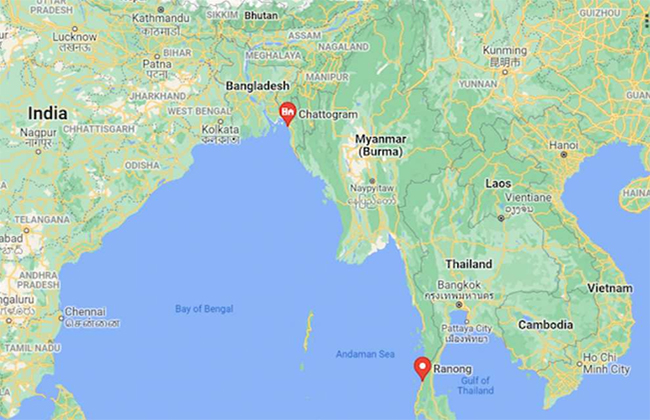
Bangladesh and Thailand are near neighbors, connected by the Bay of Bengal. The development of these maritime ties would benefit both countries in terms of trade, investment, and regional communications.
The two countries are in talks to sign a free trade agreement (FTA) to boost trade and investment. Bangladesh is geographically positioned as a gateway between ASEAN and SAARC with potential access to both for each other’s export-driven manufacturers. ASEAN includes Brunei, Cambodia, Indonesia, Laos, Malaysia, Myanmar, Philippines, Singapore, Thailand, and Vietnam, while SAARC includes Afghanistan, Bangladesh, Bhutan, India, the Maldives, Nepal, Pakistan, and Sri Lanka.
The Chattagram seaport is the main seaport in Bangladesh. 90 percent of Bangladeshi trade is conducted through the Chattagram Port Terminal, with the rest being taken up by Bangladesh’s Ports at Mangla and Payra.
Thailand’s Ranong Port is situated on the Kraburi River of the Kra Peninsula, across from Myanmar and on the Indian Ocean, coast and lies 1,220km from Chittagong.
Thailand’s Southern Economic Corridor project, approved by the Government in August 2018, emphasizes the development of Ranong port as a gateway to trade with Bangladesh, India, Myanmar, and Sri Lanka. Using Ranong port for trade with Bangladesh’s Chattagram, Payra, and Mangla ports will reduce the distance between the two countries and boost trade. Then this connectivity can then be extended to India’s Kolkata, Chennai, and Mumbai ports.
The launch of direct shipping services between Chattagram and Ranong ports has received a new push as trade between the two countries is increasing.
Bilateral trade between Bangladesh and Thailand reached US$837.08 million in 2019-20. Bangladesh’s total exports to Thailand in 2020 were US$35.46 million while imports from Thailand were worth US$801.3 million, very much in Thailand’s favor.
Bangladeshi exports to Thailand are on an upward trend, however. This year exported values are expected to reach just under US$40 million, a 12 percent increase YoY.
According to FDI stock data in Bangladesh, Thailand is the 15th largest investor in the country. This however would increase significantly if an FTA can be agreed upon, and the two countries build direct maritime connectivity between Chittagong and Ranong ports.
There is precedent. When Bangladesh signed FTA with the SAARC members in 2006, its imports and exports doubled within ten years, being a relatively constant (there was a dip in 2011) and sustainable 10% GDP growth in trade per annum.
In terms of commodities, Thailand mainly exports cement, cereals, plastics, man-made staple fibers, sugar and sugar confectionery, machinery and mechanical equipment, cotton and cotton cloth, salt, sulfur, clay, stone, and mineral fuels to Bangladesh.
In the reverse direction, Bangladesh exports garments, vegetables, textile fibers, garments, animal products, electrical and electronic equipment, frozen fish, and crustaceans to Thailand.
Direct sea connectivity between Chattagram and Ranong can be expected to play an important role in expanding trade and commerce between the two countries. The time and cost of transporting goods between them can be reduced by 30 percent and are likely to play a key role in building ties with other Southeast Asian countries, including Myanmar and India. The introduction of direct shipping between the two countries will encourage traders from both to expand their regional trade and investment.
Thailand could increase trade ties with India, Bangladesh, and Sri Lanka under the framework of the Bay of Bengal Initiative for Multi-Sectoral Technical and Economic Cooperation (BIMSTEC).
The establishment of trade and economic corridors through coordination between the Look East Policy of Bangladesh and the Look West Policy of Thailand and the establishment of connectivity through coastal shipping is likely to bring prosperity for both.
Dhaka is additionally counting on Bangkok’s support for Bangladesh’s bid for membership in the Mekong-Ganga Cooperation Forum as well as the ASEAN Sectoral Partnership.
Thailand and Bangladesh are also both active partners in the Belt and Road Initiative. If Chittagong and Ranong port connectivity can be extended to Iran’s Chabahar port and Pakistan’s Gwadar port via Sri Lanka’s Colombo and the International North South Transport Corridor project (INSTC) through to Central Asia and Turkey, this will create significant trade potential.
Although the Maritime Assistance Agreement between Bangladesh and Thailand was completed in 1986 and is currently in force, changes need to be made to bring these opportunities to fruition. But the Bangladesh and Thailand can renew the agreement for ensuring their business interests.
Progress is being made. Thai ambassador to Bangladesh, MakawadeeSumitmor stated at a bilateral business meeting with the Chittagong World Trade Center in September this year that there is a trade gap between the two countries. She also said that the expansion of the India-Myanmar-Thailand trilateral route will boost trade in this region and that she was waiting for the signing of a memorandum of understanding between Thai authorities and the Chittagong Port Authority to establish direct shipping links by sea.
There are huge opportunities for Thai investors in infrastructure, light engineering, agriculture and food processing, and tourism and healthcare. Thailand and Bangladesh both could and should utilize these potentials. But smooth connectivity is needed to boost the Trade. Chittagong and Ranong port connectivity would boost up the trade, expansion of tourism. Bangladesh and Thailand can both benefit from this mutually rewarding sea connectivity project.
Md Pathik Hasan is a Dhaka-based NGO activist and freelance writer


